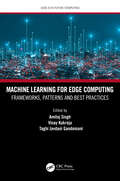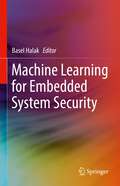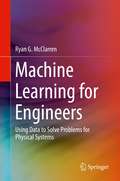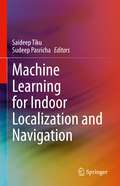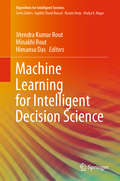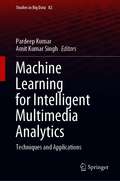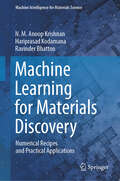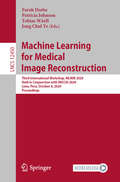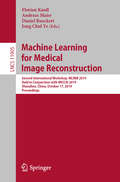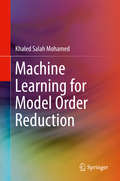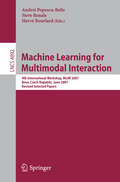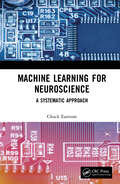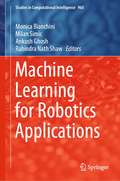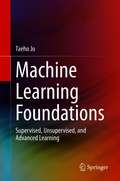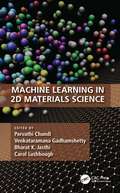- Table View
- List View
Machine Learning for Edge Computing: Frameworks, Patterns and Best Practices (ISSN)
by Amitoj Singh Vinay Kukreja Taghi Javdani GandomaniThis book divides edge intelligence into AI for edge (intelligence-enabled edge computing) and AI on edge (artificial intelligence on edge). It focuses on providing optimal solutions to the key concerns in edge computing through effective AI technologies, and it discusses how to build AI models, i.e., model training and inference, on edge. This book provides insights into this new inter-disciplinary field of edge computing from a broader vision and perspective. The authors discuss machine learning algorithms for edge computing as well as the future needs and potential of the technology. The authors also explain the core concepts, frameworks, patterns, and research roadmap, which offer the necessary background for potential future research programs in edge intelligence.The target audience of this book includes academics, research scholars, industrial experts, scientists, and postgraduate students who are working in the field of Internet of Things (IoT) or edge computing and would like to add machine learning to enhance the capabilities of their work. This book explores the following topics: Edge computing, hardware for edge computing AI, and edge virtualization techniques Edge intelligence and deep learning applications, training, and optimization Machine learning algorithms used for edge computing Reviews AI on IoT Discusses future edge computing needs Amitoj Singh is an Associate Professor at the School of Sciences of Emerging Technologies, Jagat Guru Nanak Dev Punjab State Open University, Punjab, India.Vinay Kukreja is a Professor at the Chitkara Institute of Engineering and Technology, Chitkara University, Punjab, India.Taghi Javdani Gandomani is an Assistant Professor at Shahrekord University, Shahrekord, Iran.
Machine Learning for Embedded System Security
by Basel HalakThis book comprehensively covers the state-of-the-art security applications of machine learning techniques. The first part explains the emerging solutions for anti-tamper design, IC Counterfeits detection and hardware Trojan identification. It also explains the latest development of deep-learning-based modeling attacks on physically unclonable functions and outlines the design principles of more resilient PUF architectures. The second discusses the use of machine learning to mitigate the risks of security attacks on cyber-physical systems, with a particular focus on power plants. The third part provides an in-depth insight into the principles of malware analysis in embedded systems and describes how the usage of supervised learning techniques provides an effective approach to tackle software vulnerabilities.
Machine Learning for Engineers: Using data to solve problems for physical systems
by Ryan G. McClarrenAll engineers and applied scientists will need to harness the power of machine learning to solve the highly complex and data intensive problems now emerging. This text teaches state-of-the-art machine learning technologies to students and practicing engineers from the traditionally “analog” disciplines—mechanical, aerospace, chemical, nuclear, and civil. Dr. McClarren examines these technologies from an engineering perspective and illustrates their specific value to engineers by presenting concrete examples based on physical systems. The book proceeds from basic learning models to deep neural networks, gradually increasing readers’ ability to apply modern machine learning techniques to their current work and to prepare them for future, as yet unknown, problems. Rather than taking a black box approach, the author teaches a broad range of techniques while conveying the kinds of problems best addressed by each. Examples and case studies in controls, dynamics, heat transfer, and other engineering applications are implemented in Python and the libraries scikit-learn and tensorflow, demonstrating how readers can apply the most up-to-date methods to their own problems. The book equally benefits undergraduate engineering students who wish to acquire the skills required by future employers, and practicing engineers who wish to expand and update their problem-solving toolkit.
Machine Learning for Future Wireless Communications (Wiley - IEEE)
by Fa-Long LuoA comprehensive review to the theory, application and research of machine learning for future wireless communications In one single volume, Machine Learning for Future Wireless Communications provides a comprehensive and highly accessible treatment to the theory, applications and current research developments to the technology aspects related to machine learning for wireless communications and networks. The technology development of machine learning for wireless communications has grown explosively and is one of the biggest trends in related academic, research and industry communities. Deep neural networks-based machine learning technology is a promising tool to attack the big challenge in wireless communications and networks imposed by the increasing demands in terms of capacity, coverage, latency, efficiency flexibility, compatibility, quality of experience and silicon convergence. The author – a noted expert on the topic – covers a wide range of topics including system architecture and optimization, physical-layer and cross-layer processing, air interface and protocol design, beamforming and antenna configuration, network coding and slicing, cell acquisition and handover, scheduling and rate adaption, radio access control, smart proactive caching and adaptive resource allocations. Uniquely organized into three categories: Spectrum Intelligence, Transmission Intelligence and Network Intelligence, this important resource: Offers a comprehensive review of the theory, applications and current developments of machine learning for wireless communications and networks Covers a range of topics from architecture and optimization to adaptive resource allocations Reviews state-of-the-art machine learning based solutions for network coverage Includes an overview of the applications of machine learning algorithms in future wireless networks Explores flexible backhaul and front-haul, cross-layer optimization and coding, full-duplex radio, digital front-end (DFE) and radio-frequency (RF) processing Written for professional engineers, researchers, scientists, manufacturers, network operators, software developers and graduate students, Machine Learning for Future Wireless Communications presents in 21 chapters a comprehensive review of the topic authored by an expert in the field.
Machine Learning for Future Wireless Communications (Wiley - IEEE)
A comprehensive review to the theory, application and research of machine learning for future wireless communications In one single volume, Machine Learning for Future Wireless Communications provides a comprehensive and highly accessible treatment to the theory, applications and current research developments to the technology aspects related to machine learning for wireless communications and networks. The technology development of machine learning for wireless communications has grown explosively and is one of the biggest trends in related academic, research and industry communities. Deep neural networks-based machine learning technology is a promising tool to attack the big challenge in wireless communications and networks imposed by the increasing demands in terms of capacity, coverage, latency, efficiency flexibility, compatibility, quality of experience and silicon convergence. The author – a noted expert on the topic – covers a wide range of topics including system architecture and optimization, physical-layer and cross-layer processing, air interface and protocol design, beamforming and antenna configuration, network coding and slicing, cell acquisition and handover, scheduling and rate adaption, radio access control, smart proactive caching and adaptive resource allocations. Uniquely organized into three categories: Spectrum Intelligence, Transmission Intelligence and Network Intelligence, this important resource: Offers a comprehensive review of the theory, applications and current developments of machine learning for wireless communications and networks Covers a range of topics from architecture and optimization to adaptive resource allocations Reviews state-of-the-art machine learning based solutions for network coverage Includes an overview of the applications of machine learning algorithms in future wireless networks Explores flexible backhaul and front-haul, cross-layer optimization and coding, full-duplex radio, digital front-end (DFE) and radio-frequency (RF) processing Written for professional engineers, researchers, scientists, manufacturers, network operators, software developers and graduate students, Machine Learning for Future Wireless Communications presents in 21 chapters a comprehensive review of the topic authored by an expert in the field.
Machine Learning for Indoor Localization and Navigation
by Saideep Tiku Sudeep PasrichaWhile GPS is the de-facto solution for outdoor positioning with a clear sky view, there is no prevailing technology for GPS-deprived areas, including dense city centers, urban canyons, buildings and other covered structures, and subterranean facilities such as underground mines, where GPS signals are severely attenuated or totally blocked. As an alternative to GPS for the outdoors, indoor localization using machine learning is an emerging embedded and Internet of Things (IoT) application domain that is poised to reinvent the way we navigate in various indoor environments. This book discusses advances in the applications of machine learning that enable the localization and navigation of humans, robots, and vehicles in GPS-deficient environments. The book explores key challenges in the domain, such as mobile device resource limitations, device heterogeneity, environmental uncertainties, wireless signal variations, and security vulnerabilities. Countering these challenges can improve the accuracy, reliability, predictability, and energy-efficiency of indoor localization and navigation. The book identifies severalnovel energy-efficient, real-time, and robust indoor localization techniques that utilize emerging deep machine learning and statistical techniques to address the challenges for indoor localization and navigation. In particular, the book:Provides comprehensive coverage of the application of machine learning to the domain of indoor localization;Presents techniques to adapt and optimize machine learning models for fast, energy-efficient indoor localization;Covers design and deployment of indoor localization frameworks on mobile, IoT, and embedded devices in real conditions.
Machine Learning for Intelligent Decision Science (Algorithms for Intelligent Systems)
by Jitendra Kumar Rout Minakhi Rout Himansu DasThe book discusses machine learning-based decision-making models, and presents intelligent, hybrid and adaptive methods and tools for solving complex learning and decision-making problems under conditions of uncertainty. Featuring contributions from data scientists, practitioners and educators, the book covers a range of topics relating to intelligent systems for decision science, and examines recent innovations, trends, and practical challenges in the field. The book is a valuable resource for academics, students, researchers and professionals wanting to gain insights into decision-making.
Machine Learning for Intelligent Multimedia Analytics: Techniques and Applications (Studies in Big Data #82)
by Pardeep Kumar Amit Kumar SinghThis book presents applications of machine learning techniques in processing multimedia large-scale data. Multimedia such as text, image, audio, video, and graphics stands as one of the most demanding and exciting aspects of the information era. The book discusses new challenges faced by researchers in dealing with these large-scale data and also presents innovative solutions to address several potential research problems, e.g., enabling comprehensive visual classification to fill the semantic gap by exploring large-scale data, offering a promising frontier for detailed multimedia understanding, as well as extract patterns and making effective decisions by analyzing the large collection of data.
Machine Learning for Materials Discovery: Numerical Recipes And Practical Applications (Machine Intelligence For Materials Science Ser.)
by N. M. Anoop Krishnan Hariprasad Kodamana Ravinder BhattooMachine Learning for Medical Image Reconstruction: Third International Workshop, MLMIR 2020, Held in Conjunction with MICCAI 2020, Lima, Peru, October 8, 2020, Proceedings (Lecture Notes in Computer Science #12450)
by Farah Deeba Patricia Johnson Tobias Würfl Jong Chul YeThis book constitutes the refereed proceedings of the Third International Workshop on Machine Learning for Medical Reconstruction, MLMIR 2020, held in conjunction with MICCAI 2020, in Lima, Peru, in October 2020. The workshop was held virtually. The 15 papers presented were carefully reviewed and selected from 18 submissions. The papers are organized in the following topical sections: deep learning for magnetic resonance imaging and deep learning for general image reconstruction.
Machine Learning for Medical Image Reconstruction: Second International Workshop, MLMIR 2019, Held in Conjunction with MICCAI 2019, Shenzhen, China, October 17, 2019, Proceedings (Lecture Notes in Computer Science #11905)
by Florian Knoll Andreas Maier Daniel Rueckert Jong Chul YeThis book constitutes the refereed proceedings of the Second International Workshop on Machine Learning for Medical Reconstruction, MLMIR 2019, held in conjunction with MICCAI 2019, in Shenzhen, China, in October 2019. The 24 full papers presented were carefully reviewed and selected from 32 submissions. The papers are organized in the following topical sections: deep learning for magnetic resonance imaging; deep learning for computed tomography; and deep learning for general image reconstruction.
Machine Learning for Mobile Communications (Industry 5.0)
by Chiranji Lal Chowdhary Subrata Chowdhury Sinh Cong Lam Tushar Hrishikesh JawareMachine Learning for Mobile Communications will take readers on a journey from basic to advanced knowledge about mobile communications and machine learning. For learners at the basic level, this book volume discusses a wide range of mobile communications topics from the system level, such as system design and optimization, to the user level, such as power control and resource allocation. The authors also review state-of-the-art machine learning, one of the biggest emerging trends in both academia and industry. For learners at the advanced level, this book discusses solutions for long-term problems with future mobile communications such as resource allocation, security, power control, and spectral efficiency. The book brings together some of the top mobile communications and machine learning experts throughout the world, who contributed their knowledge and experience regarding system design and optimization.This book: Discusses the 5G new radio system design and architecture as specified in 3GPP documents. Highlights the challenges including security and privacy, energy, and spectrum efficiency from the perspective of 5G new radio systems. Identifies both theoretical and practical problems that can occur in mobile communication systems. Covers machine learning techniques such as autoencoder and Q-learning in a comprehensive manner. Explores how to apply machine learning techniques to mobile systems to solve modern problems. This book is for senior undergraduate and graduate students and academic researchers in the fields of electrical engineering, electronics and communication engineering, and computer engineering.
Machine Learning for Mobile Communications (Industry 5.0)
by Chiranji Lal Chowdhary Subrata Chowdhury Sinh Cong Lam Tushar Hrishikesh JawareMachine Learning for Mobile Communications will take readers on a journey from basic to advanced knowledge about mobile communications and machine learning. For learners at the basic level, this book volume discusses a wide range of mobile communications topics from the system level, such as system design and optimization, to the user level, such as power control and resource allocation. The authors also review state-of-the-art machine learning, one of the biggest emerging trends in both academia and industry. For learners at the advanced level, this book discusses solutions for long-term problems with future mobile communications such as resource allocation, security, power control, and spectral efficiency. The book brings together some of the top mobile communications and machine learning experts throughout the world, who contributed their knowledge and experience regarding system design and optimization.This book: Discusses the 5G new radio system design and architecture as specified in 3GPP documents. Highlights the challenges including security and privacy, energy, and spectrum efficiency from the perspective of 5G new radio systems. Identifies both theoretical and practical problems that can occur in mobile communication systems. Covers machine learning techniques such as autoencoder and Q-learning in a comprehensive manner. Explores how to apply machine learning techniques to mobile systems to solve modern problems. This book is for senior undergraduate and graduate students and academic researchers in the fields of electrical engineering, electronics and communication engineering, and computer engineering.
Machine Learning for Model Order Reduction
by Khaled Salah MohamedThis Book discusses machine learning for model order reduction, which can be used in modern VLSI design to predict the behavior of an electronic circuit, via mathematical models that predict behavior. The author describes techniques to reduce significantly the time required for simulations involving large-scale ordinary differential equations, which sometimes take several days or even weeks. This method is called model order reduction (MOR), which reduces the complexity of the original large system and generates a reduced-order model (ROM) to represent the original one. Readers will gain in-depth knowledge of machine learning and model order reduction concepts, the tradeoffs involved with using various algorithms, and how to apply the techniques presented to circuit simulations and numerical analysis.Introduces machine learning algorithms at the architecture level and the algorithm levels of abstraction;Describes new, hybrid solutions for model order reduction;Presents machine learning algorithms in depth, but simply;Uses real, industrial applications to verify algorithms.
Machine Learning for Multimodal Interaction: 4th International Workshop, MLMI 2007, Brno, Czech Republic, June 28-30, 2007, Revised Selected Papers (Lecture Notes in Computer Science #4892)
by Andrei Popescu-Belis Steve Renals Hervé BourlardMachine Learning for Neuroscience: A Systematic Approach
by Chuck EasttomThis book addresses the growing need for machine learning and data mining in neuroscience. The book offers a basic overview of the neuroscience, machine learning and the required math and programming necessary to develop reliable working models. The material is presented in a easy to follow user-friendly manner and is replete with fully working machine learning code. Machine Learning for Neuroscience: A Systematic Approach, tackles the needs of neuroscience researchers and practitioners that have very little training relevant to machine learning. The first section of the book provides an overview of necessary topics in order to delve into machine learning, including basic linear algebra and Python programming. The second section provides an overview of neuroscience and is directed to the computer science oriented readers. The section covers neuroanatomy and physiology, cellular neuroscience, neurological disorders and computational neuroscience. The third section of the book then delves into how to apply machine learning and data mining to neuroscience and provides coverage of artificial neural networks (ANN), clustering, and anomaly detection. The book contains fully working code examples with downloadable working code. It also contains lab assignments and quizzes, making it appropriate for use as a textbook. The primary audience is neuroscience researchers who need to delve into machine learning, programmers assigned neuroscience related machine learning projects and students studying methods in computational neuroscience.
Machine Learning for Neuroscience: A Systematic Approach
by Chuck EasttomThis book addresses the growing need for machine learning and data mining in neuroscience. The book offers a basic overview of the neuroscience, machine learning and the required math and programming necessary to develop reliable working models. The material is presented in a easy to follow user-friendly manner and is replete with fully working machine learning code. Machine Learning for Neuroscience: A Systematic Approach, tackles the needs of neuroscience researchers and practitioners that have very little training relevant to machine learning. The first section of the book provides an overview of necessary topics in order to delve into machine learning, including basic linear algebra and Python programming. The second section provides an overview of neuroscience and is directed to the computer science oriented readers. The section covers neuroanatomy and physiology, cellular neuroscience, neurological disorders and computational neuroscience. The third section of the book then delves into how to apply machine learning and data mining to neuroscience and provides coverage of artificial neural networks (ANN), clustering, and anomaly detection. The book contains fully working code examples with downloadable working code. It also contains lab assignments and quizzes, making it appropriate for use as a textbook. The primary audience is neuroscience researchers who need to delve into machine learning, programmers assigned neuroscience related machine learning projects and students studying methods in computational neuroscience.
Machine Learning for Predictive Analysis: Proceedings of ICTIS 2020 (Lecture Notes in Networks and Systems #141)
by Amit Joshi Mahdi Khosravy Neeraj GuptaThis book gathers papers addressing state-of-the-art research in the areas of machine learning and predictive analysis, presented virtually at the Fourth International Conference on Information and Communication Technology for Intelligent Systems (ICTIS 2020), India. It covers topics such as intelligent agent and multi-agent systems in various domains, machine learning, intelligent information retrieval and business intelligence, intelligent information system development using design science principles, intelligent web mining and knowledge discovery systems.
Machine Learning for Robotics Applications (Studies in Computational Intelligence #960)
by Monica Bianchini Milan Simic Ankush Ghosh Rabindra Nath ShawMachine learning has become one of the most prevalent topics in recent years. The application of machine learning we see today is a tip of the iceberg. The machine learning revolution has just started to roll out. It is becoming an integral part of all modern electronic devices. Applications in automation areas like automotive, security and surveillance, augmented reality, smart home, retail automation and healthcare are few of them. Robotics is also rising to dominate the automated world. The future applications of machine learning in the robotics area are still undiscovered to the common readers. We are, therefore, putting an effort to write this edited book on the future applications of machine learning on robotics where several applications have been included in separate chapters. The content of the book is technical. It has been tried to cover all possible application areas of Robotics using machine learning. This book will provide the future vision on the unexplored areas of applications of Robotics using machine learning. The ideas to be presented in this book are backed up by original research results. The chapter provided here in-depth look with all necessary theory and mathematical calculations. It will be perfect for laymen and developers as it will combine both advanced and introductory material to form an argument for what machine learning could achieve in the future. It will provide a vision on future areas of application and their approach in detail. Therefore, this book will be immensely beneficial for the academicians, researchers and industry project managers to develop their new project and thereby beneficial for mankind. Original research and review works with model and build Robotics applications using Machine learning are included as chapters in this book.
Machine Learning for Smart Environments/Cities: An IoT Approach (Intelligent Systems Reference Library #121)
by Gonçalo Marques Alfonso González-Briones José Manuel Molina LópezThis book introduces machine learning and its applications in smart environments/cities. At this stage, a comprehensive understanding of smart environment/city applications is critical for supporting future research. This book includes chapters written by researchers from different countries across the globe and identifies critical threads in research and also gaps that open up new and challenging lines of research for the future. Recent advances are discussed, and thorough reviews introduce readers to critical domains. The discussion on key research topics presented in this book accelerates smart city and smart environment implementations based on IoT technologies. Consequently, this book supports future research activities aimed at developing future IoT architectures for smart environments/cities.
Machine Learning for Solar Array Monitoring, Optimization, and Control (Synthesis Lectures on Power Electronics)
by Sunil Rao Sameeksha Katoch Vivek Narayanaswamy Gowtham Muniraju Cihan Tepedelenlioglu Andreas SpaniasThe efficiency of solar energy farms requires detailed analytics and information on each panel regarding voltage, current, temperature, and irradiance. Monitoring utility-scale solar arrays was shown to minimize the cost of maintenance and help optimize the performance of the photo-voltaic arrays under various conditions. We describe a project that includes development of machine learning and signal processing algorithms along with a solar array testbed for the purpose of PV monitoring and control. The 18kW PV array testbed consists of 104 panels fitted with smart monitoring devices. Each of these devices embeds sensors, wireless transceivers, and relays that enable continuous monitoring, fault detection, and real-time connection topology changes. The facility enables networked data exchanges via the use of wireless data sharing with servers, fusion and control centers, and mobile devices. We develop machine learning and neural network algorithms for fault classification. In addition, we use weather camera data for cloud movement prediction using kernel regression techniques which serves as the input that guides topology reconfiguration. Camera and satellite sensing of skyline features as well as parameter sensing at each panel provides information for fault detection and power output optimization using topology reconfiguration achieved using programmable actuators (relays) in the SMDs. More specifically, a custom neural network algorithm guides the selection among four standardized topologies. Accuracy in fault detection is demonstrate at the level of 90+% and topology optimization provides increase in power by as much as 16% under shading.
Machine Learning for Sustainable Manufacturing in Industry 4.0: Concept, Concerns and Applications (Mathematical Engineering, Manufacturing, and Management Sciences)
by Raman Kumar Sita Rani Sehijpal SinghThe book focuses on the recent developments in the areas of error reduction, resource optimization, and revenue growth in sustainable manufacturing using machine learning. It presents the integration of smart technologies such as machine learning in the field of Industry 4.0 for better quality products and efficient manufacturing methods. Focusses on machine learning applications in Industry 4.0 ecosystem, such as resource optimization, data analysis, and predictions. Highlights the importance of the explainable machine learning model in the manufacturing processes. Presents the integration of machine learning and big data analytics from an industry 4.0 perspective. Discusses advanced computational techniques for sustainable manufacturing. Examines environmental impacts of operations and supply chain from an industry 4.0 perspective. This book provides scientific and technological insight into sustainable manufacturing by covering a wide range of machine learning applications fault detection, cyber-attack prediction, and inventory management. It further discusses resource optimization using machine learning in industry 4.0, and explainable machine learning models for industry 4.0. It will serve as an ideal reference text for senior undergraduate, graduate students, and academic researchers in the fields including mechanical engineering, manufacturing engineering, production engineering, aerospace engineering, and computer engineering.
Machine Learning for Sustainable Manufacturing in Industry 4.0: Concept, Concerns and Applications (Mathematical Engineering, Manufacturing, and Management Sciences)
The book focuses on the recent developments in the areas of error reduction, resource optimization, and revenue growth in sustainable manufacturing using machine learning. It presents the integration of smart technologies such as machine learning in the field of Industry 4.0 for better quality products and efficient manufacturing methods. Focusses on machine learning applications in Industry 4.0 ecosystem, such as resource optimization, data analysis, and predictions. Highlights the importance of the explainable machine learning model in the manufacturing processes. Presents the integration of machine learning and big data analytics from an industry 4.0 perspective. Discusses advanced computational techniques for sustainable manufacturing. Examines environmental impacts of operations and supply chain from an industry 4.0 perspective. This book provides scientific and technological insight into sustainable manufacturing by covering a wide range of machine learning applications fault detection, cyber-attack prediction, and inventory management. It further discusses resource optimization using machine learning in industry 4.0, and explainable machine learning models for industry 4.0. It will serve as an ideal reference text for senior undergraduate, graduate students, and academic researchers in the fields including mechanical engineering, manufacturing engineering, production engineering, aerospace engineering, and computer engineering.
Machine Learning Foundations: Supervised, Unsupervised, and Advanced Learning
by Taeho JoThis book provides conceptual understanding of machine learning algorithms though supervised, unsupervised, and advanced learning techniques. The book consists of four parts: foundation, supervised learning, unsupervised learning, and advanced learning. The first part provides the fundamental materials, background, and simple machine learning algorithms, as the preparation for studying machine learning algorithms. The second and the third parts provide understanding of the supervised learning algorithms and the unsupervised learning algorithms as the core parts. The last part provides advanced machine learning algorithms: ensemble learning, semi-supervised learning, temporal learning, and reinforced learning.Provides comprehensive coverage of both learning algorithms: supervised and unsupervised learning;Outlines the computation paradigm for solving classification, regression, and clustering;Features essential techniques for building the a new generation of machine learning.
Machine Learning in 2D Materials Science
by Parvathi ChundiData science and machine learning (ML) methods are increasingly being used to transform the way research is being conducted in materials science to enable new discoveries and design new materials. For any materials science researcher or student, it may be daunting to figure out if ML techniques are useful for them or, if so, which ones are applicable in their individual contexts, and how to study the effectiveness of these methods systematically. KEY FEATURES • Provides broad coverage of data science and ML fundamentals to materials science researchers so that they can confidently leverage these techniques in their research projects. • Offers introductory material in topics such as ML, data integration, and 2D materials. • Provides in-depth coverage of current ML methods for validating 2D materials using both experimental and simulation data, researching and discovering new 2D materials, and enhancing ML methods with physical properties of materials. • Discusses customized ML methods for 2D materials data and applications and high-throughput data acquisition. • Describes several case studies illustrating how ML approaches are currently leading innovations in the discovery, development, manufacturing, and deployment of 2D materials needed for strengthening industrial products. • Gives future trends in ML for 2D materials, explainable AI, and dealing with extremely large and small, diverse datasets. Aimed at materials science researchers, this book allows readers to quickly, yet thoroughly, learn the ML and AI concepts needed to ascertain the applicability of ML methods in their research.
